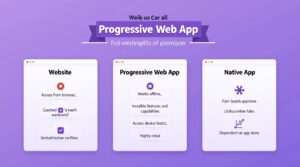click to get service View profile
Learn how to Enterprise Application Design that scales efficiently, delivers great user experience, and meets complex business needs. A complete guide to enterprise application design best practices. In today’s fast-paced digital world, enterprise applications are no longer just a luxury—they’re a must-have for businesses striving to stay competitive. Whether it’s streamlining operations, enhancing customer experiences, or making data-driven decisions, these applications power the backbone of modern enterprises.
And the numbers don’t lie—Gartner projects the enterprise application software market to soar to $569 billion by 2027. That’s a clear sign that businesses are doubling down on digital transformation to stay ahead.
But what exactly makes enterprise applications so crucial? In this blog, we’ll unpack everything you need to know—from the Enterprise Application Design definition, common types and enterprise applications examples to the benefits and challenges that come along.
Ready to future-proof your business? Let’s get started!
What is Enterprise Application?
An enterprise application is a robust, large-scale software solution built to address the complex operational needs of modern organizations. These systems streamline business processes, enhance data management, and boost efficiency across critical departments such as finance, human resources, supply chain, and customer relationship management. Effective Enterprise Application Design ensures that these solutions are scalable, user-friendly, and aligned with strategic business goals.
Key Qualities of Enterprise Application Software
Enterprise applications are built to support specific business functions. While they vary in purpose, they share common characteristics:
- Accessibility – Designed to be user-friendly and inclusive for all users, often meeting industry accessibility standards.
- Automation – Reduces manual work by automating repetitive tasks like data entry, improving efficiency and accuracy.
- Customization – Tailored to fit an organization’s needs, with flexible interfaces for different user roles.
- Integration – Connects seamlessly with other business systems to ensure smooth data flow.
- Scalability – Grows with the business without disrupting existing operations.
- Security – Protects sensitive business and customer data with strong security measures.
- Support – Requires ongoing maintenance and updates to stay efficient and aligned with business needs.
7 Types of Enterprise Applications
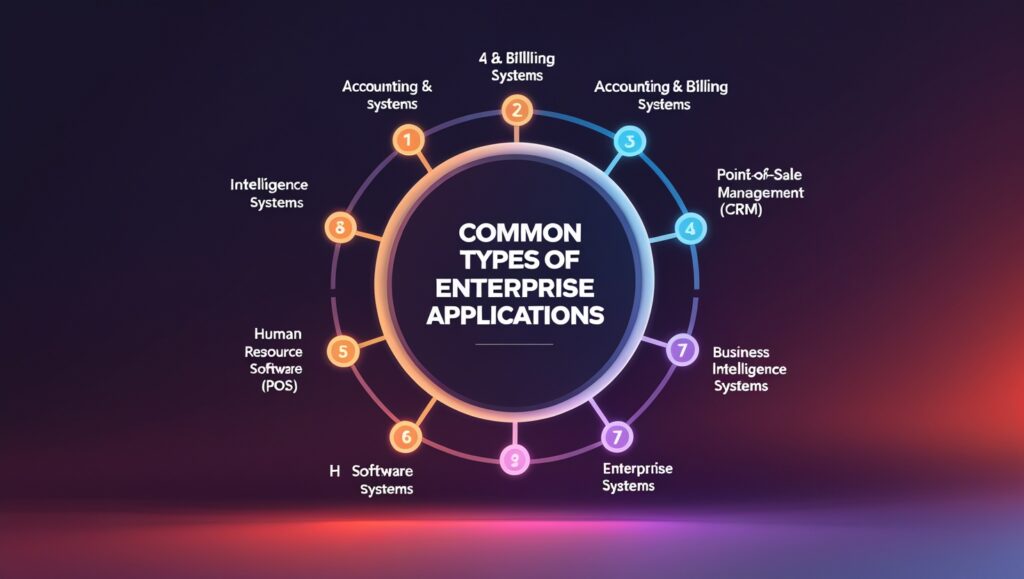
In today’s fast-paced digital landscape, enterprise business applications are essential for optimizing operations, improving productivity, and supporting sustainable growth. When backed by strategic Enterprise Application Design, these tools can deliver powerful results across various business functions. Below are 7 key types of enterprise applications and the value they bring to modern organizations:
- Accounting and Billing Systems – Handle financial transactions, automate invoicing, and ensure compliance. (E.g., QuickBooks, Xero)
- Customer Relationship Management (CRM) – Store customer data, track interactions, and optimize sales processes. (E.g., Salesforce, HubSpot)
- Point-of-sale software (POS) – Process transactions, track inventory, and generate reports. (E.g., Square, Shopify POS)
- Supply Chain Management (SCM) – Optimize logistics, inventory, and supplier management. (E.g., SAP SCM, Oracle SCM Cloud)
- Enterprise Resource Planning (ERP) – Integrate core business functions like finance, HR, procurement, and manufacturing. (E.g., SAP ERP, Microsoft Dynamics 365)
- Business Intelligence Systems – Analyze data to provide actionable insights. (E.g., Tableau, Power BI)
- Human Resource (HR) Systems – Manage payroll, recruitment, and employee performance. (E.g., Workday, BambooHR)
Why should we design Enterprise Apps?
“If you think good design is expensive, you should look at the cost of bad design” – Dr. Ralph Speth, CEO Jaguar Land Rover.
Effective Enterprise Application Design starts with understanding the real needs of real users through thorough user research. It focuses on user behavior, preferences, and the pain points that existing solutions often overlook. A thoughtfully designed enterprise app not only enhances user satisfaction but also boosts employee productivity and delivers measurable value to the entire organization.
Here’s why redesigning enterprise applications is essential, illustrated with real-world impact from one of our clients, Vymo—a leader in AI-driven sales automation:
1. Competitive Advantage
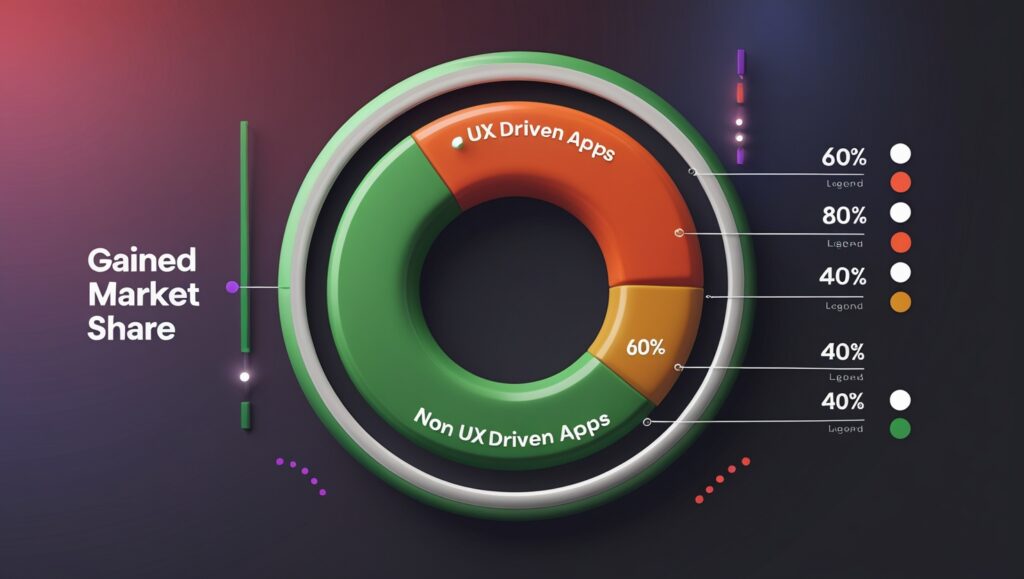
Businesses that embrace modern, agile enterprise applications gain a competitive edge over those relying on outdated legacy systems. With thoughtful Enterprise Application Design, these solutions become seamlessly integrated and user-friendly—enhancing workflow efficiency, empowering teams to work smarter and faster, and ultimately driving increased revenue and customer satisfaction.
Impact: After launching its redesigned application, Vymo quickly gained 40 major clients, including the largest banks and insurance companies in India (HDFC Bank, SBI Life Insurance, Bharti AXA General Life Insurance, Infosys Finacle,…). The brand significantly increased its market share within few months.
2. Data Optimization and Forecasting
New-generation enterprise applications harness the power of big data and AI-driven analytics to uncover valuable business insights. When supported by intelligent Enterprise Application Design, these solutions empower organizations to make informed, data-driven decisions, forecast trends accurately, and deliver personalized experiences that align with evolving customer needs.
Impact: Vymo’s data-driven approach has earned it recognition as Asia’s only Gartner Cool Vendor in CRM Sales. It was also named a notable vendor in the Gartner CRM Vendor Guide and shortlisted for AIR Agent App of the Year.
3. Enhanced Workflow Efficiency
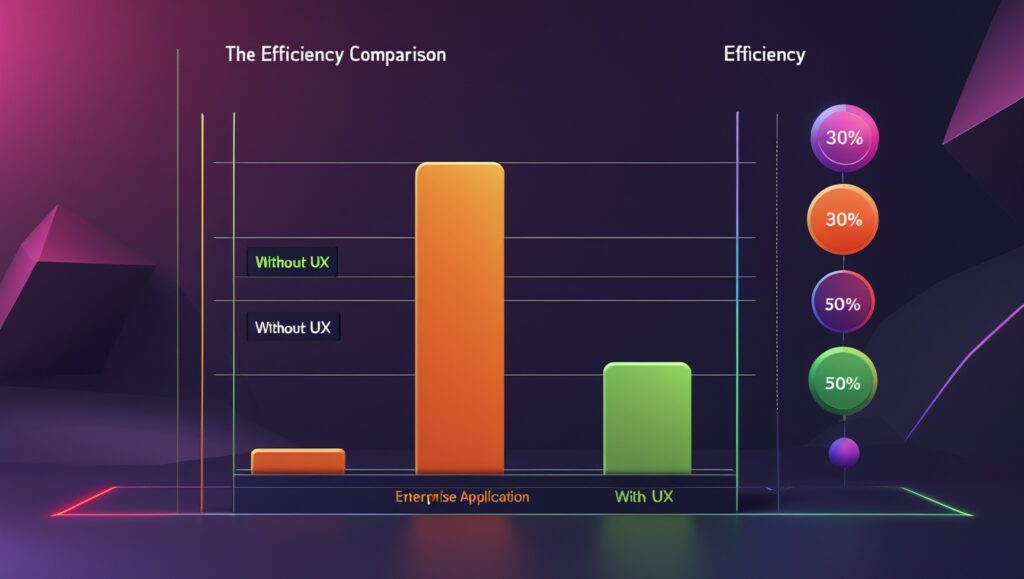
Many enterprise applications are built around rigid organizational structures rather than the actual needs of end-users, resulting in clunky interfaces and inefficient workflows. By adopting a user-centric approach to Enterprise Application Design, businesses can streamline task flows, reduce friction, and enable employees to work more efficiently—ultimately boosting overall productivity and user satisfaction.
Impact: Vymo’s redesigned enterprise app resulted in a 30-50% increase in sales within just three months of launch.
4. Minimized Cognitive Load
Many enterprise applications overwhelm users with cluttered interfaces and excessive information, making navigation confusing and inefficient. Effective Enterprise Application Design prioritizes clarity, reduces distractions, and presents contextually relevant information—enabling users to quickly access what they need and perform tasks with greater ease and confidence.
Impact: Thanks to its intuitive interface, over 80% of Vymo’s 50K-100K users actively engage with the app, demonstrating high user satisfaction and adoption.
5. Higher employee satisfaction
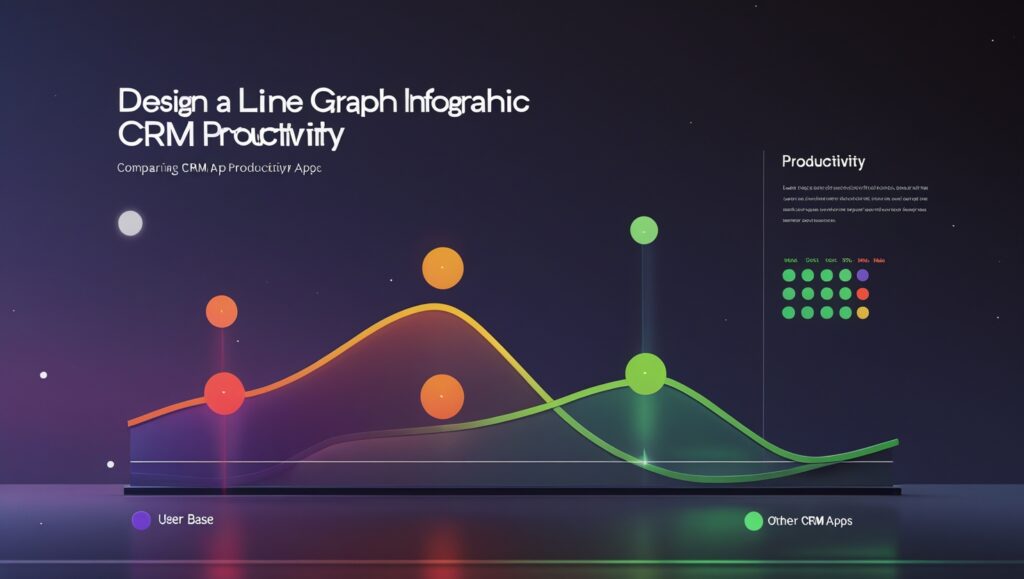
Enterprise software should empower employees—not add to their frustration. Thoughtful Enterprise Application Design simplifies complex workflows, minimizes friction, and enhances the overall user experience. By making daily tasks more intuitive and enjoyable, well-designed systems boost employee engagement, satisfaction, and long-term retention.
Impact: Vymo’s platform has helped some of the world’s largest enterprise field teams get almost 2X productivity uplift.
Challenges of enterprise application development
UX-driven enterprise applications have the potential to deliver exceptional value, but achieving success requires time, collaboration, and strategic thinking from both entrepreneurs and designers. Building an enterprise app from the ground up involves navigating a range of challenges. Effective Enterprise Application Design plays a crucial role in overcoming these obstacles and ensuring the final product is both functional and user-focused.

1. Extensive User Research
Enterprise apps must cater to a diverse range of users across departments, roles, and experience levels. Each user group may have different needs, priorities, and workflows. This makes the research phase even more critical!
To create truly effective solutions, UX designers must invest time in user interviews, surveys, and usability testing to uncover real pain points, hidden usability issues, and areas for improvement. Comprehensive research is the foundation of successful Enterprise Application Design—without it, there’s a high risk of building applications that miss the mark and fail to meet actual business needs.
In addition to user research, market research is essential to the success of any enterprise application. Gaining insights into industry trends, competitor solutions, and stakeholder expectations ensures that the product stays relevant and competitive over time. Strategic Enterprise Application Design leverages this market knowledge to build solutions that not only meet user needs but also align with broader business goals.
Skipping or rushing through this research phase can lead to poor design decisions, lower adoption rates, and increased frustration among employees.
2. Complex Cross-Platform Integration
Another major challenge lies in ensuring seamless enterprise application integration. The question is—can the application effectively connect with various processes, software systems, and frameworks while still delivering a user-friendly experience across departments? Achieving this balance is no small feat, and it requires thoughtful Enterprise Application Design that prioritizes flexibility, interoperability, and usability from the ground up.
For UX designers, the key challenge is creating an interface that connects all the existing systems into a cohesive and intuitive experience. They must ensure that employees can easily navigate between different platforms without encountering technical difficulties, confusion, or inefficiencies.
3. Lengthy Development Cycle
Building an enterprise application platform is a complex, multi-phase process that demands considerable time, effort, and collaboration. From initial ideation and in-depth research to wireframing, prototyping, development, and rigorous testing, each stage plays a crucial role. Effective Enterprise Application Design ensures that this journey results in a solution that is not only functional but also scalable, user-centric, and aligned with long-term business goals.
In addition, enterprise applications must accommodate a wide range of business needs, security requirements, and complex workflows. Every feature needs to be carefully planned, validated, and aligned with business objectives.
Without clearly defined goals from the outset, teams risk wasting valuable time on unnecessary revisions and rework. A lack of proper project management and strategic planning can quickly derail progress, leading to delays, misalignment, and increased development costs. Successful Enterprise Application Design depends on a well-structured approach that aligns goals, timelines, and team efforts from day one.
4. Barriers to Adoption and Training
Even the most well-designed enterprise applications can fail if employees do not understand how to use them effectively. Since enterprise apps often introduce new workflows and tools, the adoption phase requires significant training and onboarding efforts.
Employee resistance is a common challenge when introducing a new system, particularly if users are familiar with older tools or manual workflows. Overcoming this hesitation requires clear communication, live demonstrations, and interactive training sessions that emphasize the value and ease of the new solution. Thoughtful Enterprise Application Design can also ease adoption by creating intuitive, user-friendly experiences that reduce the learning curve and build user confidence.
Companies must also provide ongoing support, such as FAQs, video tutorials, and help desks, to address any usability concerns that arise. Without these efforts, employees may struggle to adopt the new application, leading to low engagement and decreased productivity.
5. Continuous Iteration Cycle
Enterprise Application Design is not a one-time task—it’s an ongoing process that demands continuous refinement and improvement. As businesses grow, employee needs shift, and technology evolves, the application must be regularly updated to remain relevant, efficient, and aligned with organizational goals. A commitment to iterative design ensures long-term success and user satisfaction.
Regular usability testing, feedback collection, and performance analysis are essential to identify areas for improvement. Based on these insights, designers and developers must iterate on the app—fixing usability issues, adding new features, and optimizing the overall experience.
Final thoughts
Enterprise Application Design isn’t just about building software—it’s about creating intelligent, scalable systems that solve real business problems. A well-designed enterprise app improves efficiency, enhances user satisfaction, and supports long-term growth.
By focusing on scalability, reliability, and user-centric design, businesses can future-proof their operations and gain a competitive edge in today’s fast-evolving digital landscape.
Whether you’re designing from scratch or modernizing legacy systems, investing in thoughtful Enterprise Application Design is the key to building powerful digital solutions that drive real impact.

